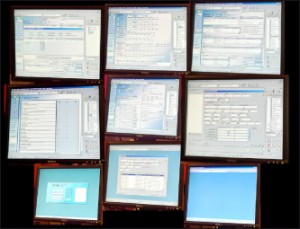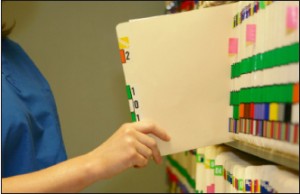Answering some of the most commonly asked questions about the adoption of EMR/EHR systems and what the transition to this new-age approach means for the healthcare industry
by Kodak
 Utilization of electronic record keeping systems is becoming increasingly predominant within the healthcare industry due to a wide range of benefits, ultimately resulting in improved quality of care and patient safety, not to mention controlled costs and time savings for healthcare providers.
Utilization of electronic record keeping systems is becoming increasingly predominant within the healthcare industry due to a wide range of benefits, ultimately resulting in improved quality of care and patient safety, not to mention controlled costs and time savings for healthcare providers.
What are the primary benefits of implementing a comprehensive EMR/ EHR system? EMR systems are designed to keep track of a patient’s entire health and medical history in an electronic, computerized format. Although it may appear to be a daunting task, storing the vast volume of patient records in a digital format makes information more readily accessible and can help healthcare workers and patients navigate through healthcare systems more safely and efficiently. Ultimately, EMR systems can improve quality of care and patient safety, control costs, save substantial time for healthcare providers and, of course, provide extensive storage capabilities in today’s data-driven era. Advantages include increased efficiency, with the ability to reduce duplication of documents; elimination of needless delays in searching for charts; intelligence capabilities such as medical and prescription drug interaction alerts and treatment reminders; and quality measures for tailoring and showcasing data in customized formats for specific specialties.
Although EMR implementations require infrastructure changes, paper-based record systems are no longer fulfilling the needs of healthcare workers.
However, the U.S. Health Information Technology for Economic and Clinical Health (HITECH) Act promises federal stimulus funding for EMR, and benefits for providers embracing this new electronic standard include streamlined measures for achieving regulatory compliance and substantial savings resulting from greater workplace efficiencies. Some reports conclude that effective EMR implementation and networking could eventually save the healthcare industry more than $80 billion annually.
Transition to digital
 How involved is the transition to digital records, and what are the necessary first steps for developing a smooth transition? Transitioning any healthcare organization from a paper-based environment to a digital one can be a complicated proposition. However, if the transition is thoroughly planned and executed, the task can be manageable and result in substantial benefits to your practice or organization. Either during the EMR/EHR selection process or when a system has been chosen and an implementation plan created, document and chart conversion needs to be addressed for the transition. Conversion of existing documents and information is critical, and requires evaluation and consideration of a scanning solution to integrate into your EMR system or to provide stand-alone document retention and access. Most scanning solutions have been validated with healthcare systems, but validation needs to be verified prior to use. Staff training on the conversion of back files and day-forward documents procedures is critical for success.
How involved is the transition to digital records, and what are the necessary first steps for developing a smooth transition? Transitioning any healthcare organization from a paper-based environment to a digital one can be a complicated proposition. However, if the transition is thoroughly planned and executed, the task can be manageable and result in substantial benefits to your practice or organization. Either during the EMR/EHR selection process or when a system has been chosen and an implementation plan created, document and chart conversion needs to be addressed for the transition. Conversion of existing documents and information is critical, and requires evaluation and consideration of a scanning solution to integrate into your EMR system or to provide stand-alone document retention and access. Most scanning solutions have been validated with healthcare systems, but validation needs to be verified prior to use. Staff training on the conversion of back files and day-forward documents procedures is critical for success.
After the paper transition is planned and executed, your organization is ready to go live, with the EMR/EHR solution providing access to paper information electronically. During the transition phase, there is likely to be a slowdown, but once the system has been fully adopted, time and cost savings will be incremental. To ensure that the transition is smooth, you need to make sure everyone in your organization is on-board, establish solid security protocols, conduct routine maintenance and backups for your system and develop a disaster recovery plan.
Patient records
What are the most significant challenges in converting existing medical records to a digital system? With today’s wide variety of paper patient records, including faxed prescriptions, physician orders, referrals, collections of signatures, medical charts and other accumulated patient information, it is hard to imagine how to convert to a paperless office. To ensure successful migration of paper charts and information to your EMR system, it is important to first determine what approach you want to use to convert your documents, files and charts. Options include:
- set up a manual in-house process, whereby documents are scanned directly into a solution if it has the capability
- purchase a solution that provides more sophisticated information indexing and allows users to scan charts into the EMR solution
- outsource the project to a service provider that specializes in document conversion for physicians and healthcare systems.
 When converting existing data and considering scanning options, first and foremost organizations need to ensure the integrity of data and image quality. They also need to consider ease of use: Is it a simple push-button process, or is it more complicated? And, of course, speed: How many scans/pages per minute are demanded? Also, is a backup scanner needed? This is important when considering the high volume of paperwork being transitioned.
When converting existing data and considering scanning options, first and foremost organizations need to ensure the integrity of data and image quality. They also need to consider ease of use: Is it a simple push-button process, or is it more complicated? And, of course, speed: How many scans/pages per minute are demanded? Also, is a backup scanner needed? This is important when considering the high volume of paperwork being transitioned.
Finally, you need to consider the level of service from the solution provider. Will the scanner provider replace or fix a unit if there are problems? How promptly will it be able to correct the issue? Will it provide guidance to help make the transition smooth? These all are questions that should be considered when selecting a solutions provider.
Scanning applications
Would any scanning solution on the market incorporate into my existing healthcare applications? Scanning is a relatively simple method for capturing electronic images of paper documents and storing them for online reference, either through a stand-alone solution or an EMR/EHR or enterprise content management (ECM) solution. This process simply replaces paper charts with images of paper documents that are readily accessible, and most providers offer solutions that integrate with existing healthcare applications.
However, what you really need to consider is how well the scanning solutions perform and whether they can be customized to work with your EMR system. The most important features to consider when selecting a scanning solution are quality of image scanned, ease of use, speed and service.
Regulations compliance
How do effective document imaging practices support compliance with HIPAA regulations? Over the past 20 years, government regulations such as HIPAA (the Health Insurance Portability and Accountability Act) have changed the way in which U.S. companies can maintain information archives, revolutionizing procedures for handling and processing personal information within healthcare facilities. These restrictions mean healthcare organizations have to maintain patient records in an efficient and effective manner, which is a difficult task when dealing with paper records. HIPAA states that any covered entity must ensure that all sealed health information is secure and protected. However, safeguarding paper documents can be very difficult when considering that they can be easily damaged or destroyed, due to fire, flood, theft or human error.
Scanning paper documents to centralized digital files enables organizations to become compliant more easily and eliminates the obvious threats to paper records. Additionally, digital documents can be encrypted along with other security measures to protect files from theft or misuse. When records have been scanned and are digital, organizations can track and audit files and users in the system, and storage becomes far more manageable.
Transition to EMR/HER
Why is selecting the right scanning solution so important for the transition to EMR/EHR? Once you have taken the leap to digital, you need to consider the most effective way to incorporate all of your existing patient documentation and information. Selecting the right scanning solution for your organization is the first step to becoming a successful “paperless” environment. What is clear is the need for a high-quality scanning solution that has proven integration and success with your chosen EMR/EHR/ECM solutions. Also, a documented conversion protocol must be established and followed as part of your organizational strategy in the transition to digital. Selecting the correct scanning solution for your transition to EMR is a critical first step that includes the conversion of paper files into electronic images that can be imported into your EMR software platform for access.
To make this transition seamless, you need to ensure your solution offers the appropriate scanning volume and high-quality images. Otherwise, this step may be a slow and arduous process. Many organizations mistakenly believe they can get by with ‘a nice little scanner’ they already have in the office, until they find that they’ve burnt it out after only a few weeks’ time.
This phase is an important step in your organization’s move into the digital era and must be considered as part of its comprehensive plan in transitioning to EMR. Shaving dollars on your document conversion step will result in wasted man-hours and frustration resulting in failure to convert your back files and day-forward documents.
As one example in leading document imaging solutions, Kodak provides a portfolio of document scanners and solutions for healthcare organizations seeking comprehensive scanning solutions to assist them in their document conversion goals. Quality is of extra importance with healthcare documentation, as legibility impacts patient safety and outcomes. The imaging company embeds imaging software that enhances cleanup, automatically rotates documents, drops colors as needed to extract specific data, deletes blank pages and captures color documents exceptionally well, including hard-copy information, colored forms, long documents and photos. All this contributes to the importance of scanning as a process in healthcare providers’ conversion to EMR/EHR systems.
